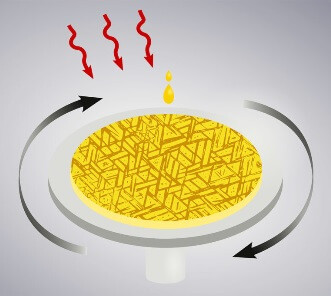Spinning could be the way to coat materials to make cheaper electronics
17-05-2019 | By Rob Coppinger
Cheaper solar cells, light emitting diodes (LED) and flexible electronics are the promise of lower cost thin films made by a spin coating process that is far cheaper than rival processes.
The spin coating process can be used with existing inorganic, non-carbon based, thin films, known as epitaxial, or overlaid, films, which are typically used for making the semiconductors for flexible electronics, LEDs and solar cells. Up to now, spin coating has been used for putting organic, carbon-based, semiconductor films onto substrates or fabricating lithographic polymer coatings. These organic films either have no crystalline structure or are polycrystalline – where crystalline parts are randomly organised in the structure. For the latest in electronics technology, films need to be epitaxial, to have an ordered crystalline structure.
“We’ve learned to use spin coating to make highly oriented films and nanocrystals on a variety of inorganic substrates,” says Missouri University of Science and Technology chemical research professor, Jay Switzer. “Until now, atomically perfect epitaxial films have been made by several other methods, and some of those are very expensive and require ultra-high vacuum.”
Researchers expect to be able to make solar cells more efficient with this spin coating process with inorganic epitaxial films. Epitaxy is the growth of crystals, or thin films, whose orientation is determined by the crystalline substrate they are layered on. When the atomic structure of these crystals aligns with their substrate, the result is a film with better electronic and optical properties, equalling the characteristics of more expensive non-aligned crystals.

Schematic of spin coating process used to produce epitaxial films and nanocrystals. Credit: Missouri University of Science and Technology
Spinning
“We’ve come up with a super-easy method that has never been done before to make these films from a solution using commercial spin coaters,” says Switzer. “This is an inexpensive and readily accessible route to single-crystal-like materials that should exhibit superior electronic and optical properties.”
Developing their spin coating process, for two years the Missouri researchers demonstrated that they could produce epitaxial films made of non-carbon materials, such as lead iodide, zinc oxide and sodium chloride. They also found that perovskite crystal structures could also be deposited by simply spin coating their solutions. Switzer’s team realised that the highly ordered epitaxial deposits of the perovskite material cesium lead bromide could lead to more efficient solar cells. Cesium lead bromide is a novel semiconductor used in photovoltaic cells.
The alternative methods that Switzer’s researchers believe their process is cheaper than include molecular beam epitaxy (MBE), chemical vapor deposition, liquid-phase epitaxy, hydrothermal processing, chemical bath deposition and electrodeposition. Some of these methods are limited by high temperature and pressure requirements. And according to Missouri University the MBE machines cost more than $1 million for the large production systems that would be needed to serve a commercial market. The MBE machines also have the drawback that they must be dedicated to one material. Funding for the Missouri work was from a United States government Department of Energy grant.
